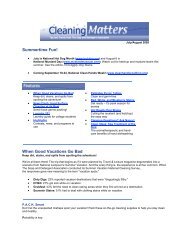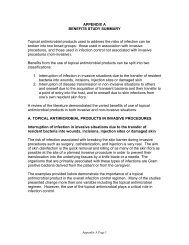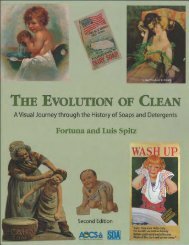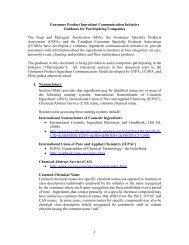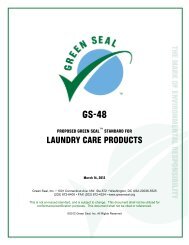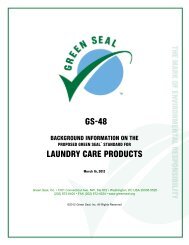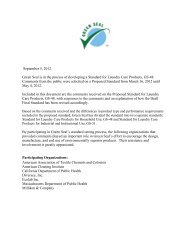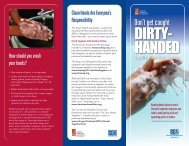subchapter c -- federal hazardous substances act regulations
subchapter c -- federal hazardous substances act regulations
subchapter c -- federal hazardous substances act regulations
Create successful ePaper yourself
Turn your PDF publications into a flip-book with our unique Google optimized e-Paper software.
limited to, a garage, carport, barn, or storage<br />
shed. The term includes articles, such as<br />
polishes or cleaners, designed primarily for<br />
professional use but which are available in<br />
retail stores, such as hobby shops, for<br />
nonprofessional use. Also included are items,<br />
such as antifreeze and radiator cleaners, that<br />
although principally for car use may be stored<br />
in or around dwelling places. The term does<br />
not include industrial supplies that might be<br />
taken into a home by a serviceman. An article<br />
labeled as, and marketed solely for, industrial<br />
use does not become subject to this <strong>act</strong><br />
because of the possibility that an industrial<br />
worker may take a supply for his own use.<br />
Size of unit or container is not the only index<br />
of whether the article is suitable for use in or<br />
around the household; the test shall be whether<br />
under any reasonably foreseeable condition of<br />
purchase, storage, or use the article may be<br />
found in or around a dwelling.<br />
(iii) Conspicuously in section 2(p)(1) of the<br />
<strong>act</strong> and prominently and conspicuous in<br />
section 2(p)(2) of the <strong>act</strong> mean that, under<br />
customary conditions of purchase, storage, and<br />
use, the required information shall be visible,<br />
noticeable, and in clear and legible English.<br />
Some f<strong>act</strong>ors affecting a warning's prominence<br />
and conspicuousness are: Location, size of<br />
type, and contrast of printing against<br />
background. Also bearing on the effectiveness<br />
of a warning might be the effect of the<br />
package contents if spilled on the label.<br />
NOTE: The definitions of extremely flammable,<br />
flammable, and combustible <strong>hazardous</strong> <strong>substances</strong> set<br />
forth above in paragraphs (b)(10) and (c)(6) are effective<br />
August 10, 1987. The definitions remaining in effect<br />
until August 10, 1987, as published at 38 FR 27012,<br />
Sept. 27, 1973, and amended at 38 FR 30105, Nov. 1,<br />
1973, are set forth below. Manuf<strong>act</strong>urers and labelers of<br />
products subject to the Federal Hazardous Substances<br />
Act may continue to use these definitions for labeling of<br />
those products under the conditions set forth in §<br />
1500.3(c)(6)(iv), as amended.<br />
(b)(10) Extremely flammable shall apply to any<br />
substance which has a flashpoint at or below 20 deg.F. as<br />
determined by the Tagliabue Open Cup Tester;<br />
flammable shall apply to any substance which has a<br />
flashpoint of above 20 deg.F., to and including 80 deg.F.,<br />
as determined by the Tagliabue Open Cup Tester; and<br />
combustible shall apply to any substance which has a<br />
flashpoint above 80 deg.F. to and including 150 deg.F.,<br />
as determined by the Tagliabue Open Cup Tester; except<br />
that the flammability or combustibility of solids and of<br />
the contents of self-pressurized containers shall be<br />
determined by methods found by the Commission to be<br />
generally applicable to such materials or containers,<br />
16 CFR Ch. II (1–1–05 Edition)—proposed modificication – 6/25/06<br />
respectively, and established by <strong>regulations</strong> issued by the<br />
Commission, which <strong>regulations</strong> shall also define the<br />
terms flammable, combustible, and extremely flammable<br />
in accord with such methods.<br />
* * * * *<br />
(c)(6)(i) Extremely flammable means any substance<br />
that has a flashpoint at or below 20 deg.F. as determined<br />
by the method described in § 1500.43.<br />
(ii)<br />
Flammable means any substance that<br />
has a flashpoint of above 20 deg.F., to and including 80<br />
deg.F., as determined by the method described in §<br />
1500.43.<br />
§ 1500.4 Human experience with <strong>hazardous</strong><br />
<strong>substances</strong>.<br />
(a) Reliable data on human experience<br />
with any substance should be taken into<br />
account in determining whether an article is a<br />
”<strong>hazardous</strong> substance” within the meaning of<br />
the <strong>act</strong>. When such data give reliable results<br />
different from results with animal data, the<br />
human experience takes precedence.<br />
(b) Experience may show that an article is<br />
more or less toxic, irritant, or corrosive to man<br />
than to test animals. It may show other f<strong>act</strong>ors<br />
that are important in determining the degree of<br />
hazard to humans represented by the<br />
substance. For example, experience shows that<br />
radiator antifreeze is likely to be stored in the<br />
household or garage and likely to be ingested<br />
in significant quantities by some persons. It<br />
also shows that a particular substance in liquid<br />
form is more likely to be ingested than the<br />
same substance in a paste or a solid and that an<br />
aerosol is more likely to get into the eyes and<br />
the nasal passages than a liquid.<br />
§ 1500.5 Hazardous mixtures.<br />
For a mixture of <strong>substances</strong>, the<br />
determination of whether the mixture is a<br />
”<strong>hazardous</strong> substance” as defined by section<br />
2(f) of the <strong>act</strong> (repeated in §1500.3(b)(4))<br />
should be based on the physical, chemical, and<br />
pharmacological char<strong>act</strong>eristics of the mixture.<br />
A mixture of <strong>substances</strong> may therefore be less<br />
<strong>hazardous</strong> or more <strong>hazardous</strong> than its<br />
components because of synergistic or<br />
antagonistic re<strong>act</strong>ions. It may not be possible<br />
to reach a fully satisf<strong>act</strong>ory decision<br />
concerning the toxic, irritant, corrosive,<br />
flammable, sensitizing, or pressure-generating<br />
properties of a substance from what is known<br />
about its components or ingredients. In such<br />
cases, the mixture itself should be tested.<br />
However, in other cases, it may be possible to<br />
Deleted: The<br />
-- 11 --



